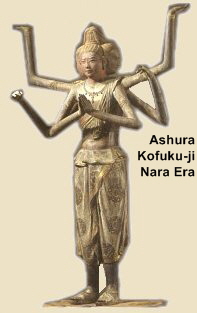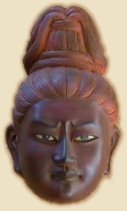 Alright. I'm obsessed with this sculpture. I was planning to write my MD's disses on it, but apparently, I had no supervisor, so I had to change my plans. I see Ashūra even in my dreams.
Alright. I'm obsessed with this sculpture. I was planning to write my MD's disses on it, but apparently, I had no supervisor, so I had to change my plans. I see Ashūra even in my dreams.Hachi Bushū (Hachibushu, Hachibushuu) 八部衆
Eight Legions, Eight Deva Guardians of Buddhism
Also called Ninpinin 人非人 = Lit. Human & Non-Human
Also called Tenryū Kijin 天龍鬼神 = Deva, Naga, Demons, Gods
Also Tenryū Hachibushū 天竜八部衆 = Deva, Naga, Others Members of Eight Classes
Members of the TENBU, Members of the 28 LEGIONSHachi Bushū (Hachibushu, Hachibushuu)
Eight Legions, Eight Deva Guardians of Buddhism
Also called Ninpinin 人非人 = Lit. Human & Non-Human
Also called Tenryū Kijin 天龍鬼神 = Deva, Naga, Demons, Gods
Also Tenryū Hachibushū 天竜八部衆 = Deva, Naga, Others Members of Eight Classes
Members of the TENBU, Members of the 28 LEGIONSHachi Bushū (Hachibushu, Hachibushuu)
- Ten (Skt: Deva). Celestial beings, 6th level of existence
- Ryū (Ryu, Ryuu) (Skt: Naga). Serpent-like creatures, including dragons. Attendants to Kōmokuten (Shitennō)
- Yasha (Skt: Yaksa). Warriors of Fierce Stance, Nature Spirits.
Protect Yakushi Nyorai, commanded by Tamonten (Shitennō) - Kendatsuba (Skt: Gandharva). Gods of music, medicine, children. Commanded by Jikokuten (Shitennō); one of their kings is Sendan Kendatsuba
- Ashura (Skt: Asura). Demigod, 4th level of existence
- Karura (Skt: Garuda) Bird-man, enemy of dragons
- Kinnara (Skt: Kimnara). Celestial musicians & dancers; human form with horse’s head; commanded by Tamonten (Shitennō)
- Magoraka (Skt: Mahoraga). Serpentine musicians (credits: here)
Ashura 阿修羅
Skt: Ashura, Asura
 Beings just below humans in the Six States of Existence. Asuras are demigods, or semi-blessed beings. They are powerful, yet fierce and quarrelsome, and like humans, they are partly good and partly evil. In their earliest Hindu and Brahman manifestations, the Ashura are always fighting the Ten (Deva) for supremancy (often battling the deities commanded by Taishakuten, the Lord Indra of Hindu mythology). The Ashura are sometimes compared to the Titans of Greek mythology -- in one legend, they stand in the ocean with the water coming up to only their knees. But in most accounts, the Ashura are not giants. Some say Ashura was an Indian royal who converted to Buddhism. In other Hindu traditions, Ashura is a sun goddess, feared for bringing droughts.
Beings just below humans in the Six States of Existence. Asuras are demigods, or semi-blessed beings. They are powerful, yet fierce and quarrelsome, and like humans, they are partly good and partly evil. In their earliest Hindu and Brahman manifestations, the Ashura are always fighting the Ten (Deva) for supremancy (often battling the deities commanded by Taishakuten, the Lord Indra of Hindu mythology). The Ashura are sometimes compared to the Titans of Greek mythology -- in one legend, they stand in the ocean with the water coming up to only their knees. But in most accounts, the Ashura are not giants. Some say Ashura was an Indian royal who converted to Buddhism. In other Hindu traditions, Ashura is a sun goddess, feared for bringing droughts.  In early Vedic legends, which celebrate the victory of the Aryan invaders who entered India around 1500 BC and conquered the local Dravidian people, we find mention of the Asura King (Ashura O). The Aryans portrayed their own gods as benevolent heavenly beings, while the gods of the conquered people were demoted to serving as subjects of the Aryan deities. But the Asura King, one of the major gods of the conquered Dravidians, was a threat to the victors, and was subsequently demoted to demon status. According to Aryan lore, Asura was defeated by Taishakuten (Indra) and hid thereafter in a lotus flower growing in the Icy Lake (Skt. = Anavatapta). The word asura was then sometimes translated as “non-god” or “anti-god” to complete the Aryan victory and to deny any chance of ranking the Asura among the heavenly gods. But with the emergence of Buddhism, Ashura is sometimes identified with sunshine and helping crops to grow. Many sources depict the Asura as demons, yet they are not always portrayed as sinister, and some are even godlike in their piousness. Among the truly evil was Vritra.
In early Vedic legends, which celebrate the victory of the Aryan invaders who entered India around 1500 BC and conquered the local Dravidian people, we find mention of the Asura King (Ashura O). The Aryans portrayed their own gods as benevolent heavenly beings, while the gods of the conquered people were demoted to serving as subjects of the Aryan deities. But the Asura King, one of the major gods of the conquered Dravidians, was a threat to the victors, and was subsequently demoted to demon status. According to Aryan lore, Asura was defeated by Taishakuten (Indra) and hid thereafter in a lotus flower growing in the Icy Lake (Skt. = Anavatapta). The word asura was then sometimes translated as “non-god” or “anti-god” to complete the Aryan victory and to deny any chance of ranking the Asura among the heavenly gods. But with the emergence of Buddhism, Ashura is sometimes identified with sunshine and helping crops to grow. Many sources depict the Asura as demons, yet they are not always portrayed as sinister, and some are even godlike in their piousness. Among the truly evil was Vritra. In Japan, Ashura is often shown with three faces and six arms, with the side faces often expressing the violent warrior aspects associated with Ashura’s Hindu origin. With Ashura’s arrival to Japan in the 6th century from Korea and China, the deity is adopted as a guardian deity of Buddhism.
SAYS JAANUS
 (Japanese Architecture & Art Net Users System): Sanskrit = Ashura. Also abbreviated to shura 修羅. Among the Indo-Iranians, the term asura, ahura in Avestan, originally referred to a divine being on a par with the gods, in which sense it is preserved in Ahura Mazda, the name of the supreme deity in Zoroastrianism. After the Aryans separated from the Iranians, the asura gradually declined in status, and the term acquired the opposite meaning of an antigod, demon, or enemy of the gods (Ten 天). The struggles between Indra, (Jp: Taishakuten 帝釈天) and the asura are an important theme in Indian mythology, and it is probable that they reflect the Aryans' struggles against the earlier inhabitants of India. This dual nature of the asura is also reflected in Buddhism, where on the one hand they are counted among the eight classes of beings who protect Buddhism (Hachibushuu, this page) while on the other hand their realm (said to be located on the ocean floor) is considered to be a world of strife and represents one of the six realms of transmigratory existence (rokudou-e 六道会). The Gekongoubu-in 外金剛部院 of the Taizoukai Mandara includes several asura, all two-armed and seated, but in Japan they usually are found in sets of the Hachibushuu, the eight kinds of guardian spirits of the Dharma (Buddhist law), when they are represented with three faces and six arms. The oldest statuary representation of Ashura is an 8c seated clay image at Houryuuji 法隆寺 in Nara. The most famous Ashura sculpture is a hollow dry-lacquer standing image of the 8c at Koufukuji 興福寺 in Nara. (credits: here)
(Japanese Architecture & Art Net Users System): Sanskrit = Ashura. Also abbreviated to shura 修羅. Among the Indo-Iranians, the term asura, ahura in Avestan, originally referred to a divine being on a par with the gods, in which sense it is preserved in Ahura Mazda, the name of the supreme deity in Zoroastrianism. After the Aryans separated from the Iranians, the asura gradually declined in status, and the term acquired the opposite meaning of an antigod, demon, or enemy of the gods (Ten 天). The struggles between Indra, (Jp: Taishakuten 帝釈天) and the asura are an important theme in Indian mythology, and it is probable that they reflect the Aryans' struggles against the earlier inhabitants of India. This dual nature of the asura is also reflected in Buddhism, where on the one hand they are counted among the eight classes of beings who protect Buddhism (Hachibushuu, this page) while on the other hand their realm (said to be located on the ocean floor) is considered to be a world of strife and represents one of the six realms of transmigratory existence (rokudou-e 六道会). The Gekongoubu-in 外金剛部院 of the Taizoukai Mandara includes several asura, all two-armed and seated, but in Japan they usually are found in sets of the Hachibushuu, the eight kinds of guardian spirits of the Dharma (Buddhist law), when they are represented with three faces and six arms. The oldest statuary representation of Ashura is an 8c seated clay image at Houryuuji 法隆寺 in Nara. The most famous Ashura sculpture is a hollow dry-lacquer standing image of the 8c at Koufukuji 興福寺 in Nara. (credits: here)(to be continued, I will write something on kanshitsu technique used in making that wonder^^)


